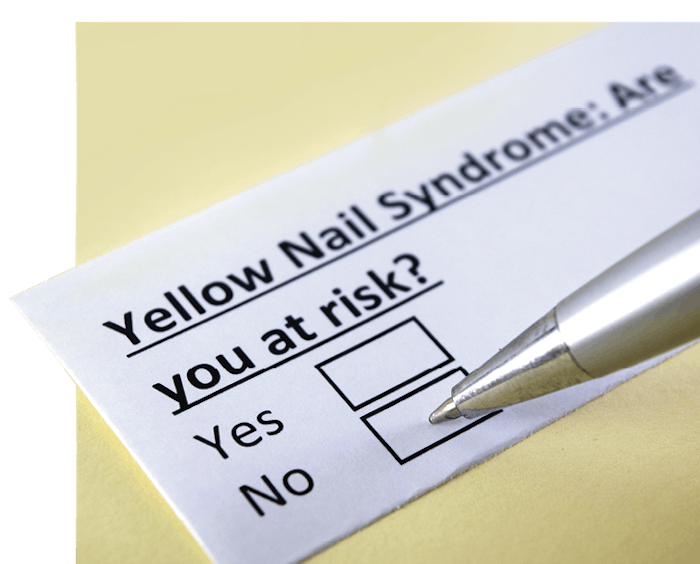
You’ve likely seen your fair share of nails stained yellow after the removal of dark polish, but there’s a more serious cause of yellowed nails known as yellow nail syndrome (YNS).
It’s important to familiarize yourself with YNS despite its rarity, as its symptoms can be life-threatening.
History and Cause
YNS effect fingernails and toenails. It most commonly impacts adults over 50, although children and even newborns can be impacted.
In 2017, the Orphanet Journal of Rare Diseases cited fewer than 400 cases of YNS reported in medical literature, the earliest of which was published in 1927. A more detailed review of 13 YNS cases was published in 1964, giving doctors better insight into the rare disease.
There’s little evidence to suggest that YNS is inherited. Some studies have linked the disease to abnormal lymphatic drainage; others have suggested an association between the development of YNS and exposure to titanium-containing dental implants.
Diagnosis
Board-certified dermatologist Dr. Patricia Gaile Espinosa stresses the importance of a thorough physical examination and a proper history intake to avoid a misdiagnosis of YNS. “No specific test can diagnose YNS,” says Espinosa, “although tests for infections, a chest radiography and an analysis of nail scrapings can [be performed]” to diagnosis or rule out YNS.
Nail infections might cause yellow nails, so doctors must rule out any possible nail infections before diagnosing a patient with YNS. Interestingly, some individuals with YNS may develop nail fold infections, known as paronychia.
A biopsy of the nail is conducted to verify the presence of fungus, mold or yeast. A negative biopsy, indicating the absence of fungus, mold and yeast, would lead a doctor to consider a diagnosis of a more systemic condition, such as lymphedema. “If these other conditions are present and a negative toenail biopsy occurs, one should consider a diagnosis of YNS,” says foot and ankle surgeon Dr. Bruce Pinker.
YNS Signs and Symptoms
Lymphedema - Swelling due to a build-up of lymph fluid in the body.
Sinusitis - A sinus infection resulting in a blocked or stuffy nose.
Bronchiectasis - Symptoms include a cough with mucus and frequent infections.
Pleural effusion - A condition in which excess fluid builds around the lung.
Onycholysis - Nail separation from the nail bed.
You’ve likely seen your fair share of nails stained yellow after the removal of dark polish, but there’s a more serious cause of yellowed nails known as yellow nail syndrome (YNS). It’s important to familiarize yourself with YNS despite its rarity, as its symptoms can be life-threatening.
Symptoms
YNS typically causes the nails to curve, thicken or separate from the nail bed, and it may slow or halt nail growth.
Those with YNS will not necessarily have yellow nails. Their nails might appear normal, pale yellow or even dark green. However, as indicated in the Orphanet Journal review of YNS, a doctor would have difficulty diagnosing the disease without the tell-tale nail discoloration, even with the presence of lymphatic or respiratory health problems.
Lymphedema is listed as an initial symptom in one-third of the diagnosed cases of YNS, and those afflicted with YNS often suffer respiratory problems, such as a chronic cough, fluid in the lungs or swelling or puffiness in the lower extremities. In 2008, the journal Chest analyzed 41 cases of YNS and found that 63 percent of patients with the disease had lymphedema and all but one suffered from chronic respiratory issues. Of these patients, more than 40 percent had fluid in their lungs, and a similar percentage of patients had a cough.
Once symptom certainly indicates YNS, says Pinker. “If the nail is partially or fully detached and thick without a cuticle, YNS is likely.”
Treatment
Treatment for YNS symptoms might include antibiotics, corticosteroid therapy and surgery to address respiratory issues. More than half the patients with YNS examined in the Chest study successfully managed their symptoms using these treatments. “The goal of treatment is to manage symptoms, as there’s no cure for YNS,” says Espinosa.
The Orphanet Journal reported that vitamin E was more effective in treating YNS when paired with antifungal medications, and that some cases of YNS spontaneously ceased on their own.
Biotin supplementation might help slow-growing nails, although it would have no effect if the nail has already stopped growing. “If the nail is traumatized, yellow and grows slowly, there just aren’t many treament options available,” says Pinker. “Some patients choose to have nails removed if they find them unsightly or if they cause pain or soreness.”
The prevalent symptoms of YNS can negatively impact quality of life. It’s critical to see a doctor for a proper diagnosis.
YNS by the Numbers
1964:First analysis of known YNS cases published
400: Number of confirmed cases of YNS reported worldwide as of 2017
50+: Age group most at risk for YNS
1/3: Percentage of people with YNS who report swelling as their first symptom
About the Author:
Virginia Pelley is a freelance writer and editor based in Tampa, Florida.
















